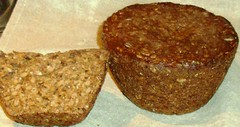May 16, 2010 - 2:55pm

Horst Bandel's Black Pumpernickel
Hi
This is just a quickie to show how I prefer this bread; as a steamed "pudding". The "Pullman Pan" is ideal to make sandwiches, but I prefer not to bake this loaf. Steaming time for a 600g loaf is about 8 hours! Cool, then wrap in linen for 24 hours. Finally, this loaf can now be sliced for eating; AND, it's so good!
Photographic evidence attached:



Best wishes
Andy


Comments
I can see the rye berries and chops in your crumb shot. With a bread like this, I am coming to understand the dilemma it poses: to treat it like a dough or more like a pudding.
In either event, your outcome looks delicious!
Larry
and those berry chops are the final touch. It makes me drool
That pumpernickel looks wonderful!
David
A very hearty bread, Andy.
I steam my veggies in the winter, but have not heard of steaming bread before.
How is it done?
I am also interested in how Andy steamed his...if you want to see how I steamed mine check it out here
http://www.thefreshloaf.com/node/17551/horst-bandel039s-pumpernickel-quotbreadquot
Looks great- a lot more moist than your previous one, yes? Why did you choose to steam it only for 8 hours-any particular reason?
Christina
Hi and thanks for your comments.
I treated this bread exactly how I would a Christmans Pudding when it came to cooking.
Once the mix had proved to near the top of the puidding pot, I attached an aluminium foil lid, and set both pots away to steam.
I did this on the stove top in pans like these: http://www.google.co.uk/imgres?imgurl=http://img.alibaba.com/photo/103788666/steaming_pan.summ.jpg&imgrefurl=http://www.alibaba.com/product/hk102491346-103799111-0/2pcs_pan_porcelain_enamel_.html&usg=__TdxGIdFLVlgQuIst9qY5yejQSfY=&h=90&w=100&sz=4&hl=en&start=84&um=1&itbs=1&tbnid=hvOH7UU7xhuDPM:&tbnh=74&tbnw=82&prev=/images%3Fq%3Dsteaming%2Bpans%26start%3D80%26um%3D1%26hl%3Den%26sa%3DN%26ndsp%3D20%26tbs%3Disch:1
One pot had c650g mix in, the other took 380g. The mix was pretty much like the consistency shown in the photos on my original post, here: http://www.thefreshloaf.com/node/17254/horst-bandel039s-balck-pumpernickel
I think this was possibly a little stiffer than yours Christina, going by your post. Also, the stove top will cook slightly quicker than the dull oven. Then the weight of mix to cook was much lower than the 2kg I tried to deal with in a Pullman Pan. The pan loaf I baked was hard on the outside; I didn't like that texture, although the bread flavour was great. These puddings are vastly superior finished products.
I'd rather have the shape of the pan loaf, but I'm over the moon with the finished products now. These 2 loaves don't even last my wife and I for the rest of the week! However, I won't be cutting into them until tomorrow now.
Best wishes
Andy
That's exactly the outcome I was hoping for Andy. Beautiful moist and full of flavor. Well done!
Eric
A big step in the right direction! What do you think about steaming the dough inside a glass tube?
Mini
Hi Mini
.....like a milk loaf pan, except corrugated glass?
That would be mighty attractive, don't you think?
Best wishes
Andy
What an idea! I loved this recipe, even when it tormented me a while back. Recently I tried to make traditional steamed pudding for the first time as a part of Daring Bakers challenge, liked those too. Your method of combining the two is so creative! I must try that soon!
When I made those English steamed puddings, I steamed them in my slow cooker. Set for a few hours and just leave it. Would that work for this? The size and shape would be limited, but would be quite easy.
Hi Andy,
In my limited experience eating pumpernickel bread, I have never seen a commercial one that looks like that. I am used to seeing dense, dark homogeneous texture. Yours look great. The rye berries and chops are so chunky and create such a beautiful mosaic. Is the texture soft, chewy or crunchy?
Don
Hi All
Thanks to Larry, Nico, David and Eric for your compliments
To Lindy and Christina; I hope my previous post answered your questions; thanks again
txfarmer, and developing what I wrote above as response to Lindy and Christina: these are made as puddings. It's not my preferred shape, but it does fit into my steaming pans. Slow cooker is ideal!
Mini, thank you; I'd love to have a glass tube which fitted snuggly into my steaming pan. What do you think about my "milk loaf pan" idea?
Don, thank you. Eric sent me a mail on a rye bread of this style which didn't utilise a ferment. Well, obviously we're not in ciabatta territory here, but I do like some aeration for sure. I tend to pat the rye paste around 2/3 full, then start the cooking when it rises close to the top of the pot.
I don't have chops; I have cracked grain. The whole grain is soaked overnight, then cooked for an hour. The cracked grain is added raw to the paste mix. Texture of finished loaf: soft to the point of being moist: check! Chewy: yes, pretty much! Crunchy: no, definitely not!
Thanks to all, and best wishes
Andy
That looks amazing! I just remembered that I was going to get back to you about the fish kettle measurements, and somewhere I got distracted, I am so sorry Andy. But it looks as if you have made something extraordinary there! Does it have a steamed pudding quality to it or is it more pumpernickel. or something new and unique? It looks really delicious either way. all the best Zeb
Hi Daisy_A,
I hoped you might latch onto this.
The formula is scaled down, yielding just short of a kilo of mix.
Apart from two things:
1.I had plenty of strong white flour in stock, so used that as the entire flour addition in the final dough, rather than the wholemeal and dark rye used in the original formula.
2. I have reverted to using rye sour at 100 flour: 167 water, as opposed to 100:100 in the original post; so, no addition of water is needed in the final dough
See Below:
Rye Sour 80 [flour 30, water 50]
Soaked bread 28.7 [old bread 11, water 17.7]
Soaked and cooked rye berries 42.7 [grain 20, water absorbed 22.7]
Salt 1.8
Molasses 4
Cracked Rye Grain 25
Strong White flour 15
TOTAL 197.2
Multiply this by 4 gives 197.2 x 4 = 986g
Best wishes
Andy
Thanks Andy - and Christina - for the steaming information.
Do you have to add water to the container at some point? I would think that some of the water would evaoperate. I noticed Christina steamed hers for around 10 hours.
Fascinating stuff.
In my scenario I did not have to add water..there was a thin layer of water left when I took it out of the oven. I tried to make sure to seal the lid as much as possible-it ended up letting so little steam out that I was deprived of the marvelous aromas that are supposed to occur when baking this bread.
I've been giving this some thought. When I bake any version of "Mini's" rye I actually "float" a bit of water on top of the batter after using my skewer to punch a bunch of holes. The time I forgot, the crust was much harder and chewier, usually there is very little crust and the water is nearly absorbed when the bake is done. I bake in my Pullman pan. My best loaf to date, I baked for about 6 hours on 225, it was amazingly complex in flavor. I'm thinking about doing Hamelman's pumpernickel and was considering some sort of bread pan in my largest crockpot. As the settings are only low, medium and high I'd probably set to low and put a few inches of water in the bottom. Any thoughts? It's been a month or so since I used my starter so I'll need to feed for a few days first. I've really neglected it but was having starter issues this summer in my warm kitchen and have lately been playing with some yeasted breads. I'm planning to also try TXFarmer's lovely 36 hour baguette with rye starter while I'm at it. And perhaps an Eric's favorite rye, our favorite sandwich bread.
Hi Doc Tracy,
You'd have to give more detail on the crock pot; not totally sure what you mean.
Meantime, I've started cooking these loaves in the "combi oven" we have in my bakery kitchen in College. I scale 2kg of the paste into a "Pullman Pan", and that will take around 16 hours on the steaming setting, which, of course runs at 100*C. Fantastic end product, but needs plenty of resting time before cutting into the finished loaf.
Rye sours are pretty forgiving, so a good feeding regime should bring it back to life: just get using it to make more breads, and enjoy!
Not heard from you in a while, good to see you around again
BW
Andy